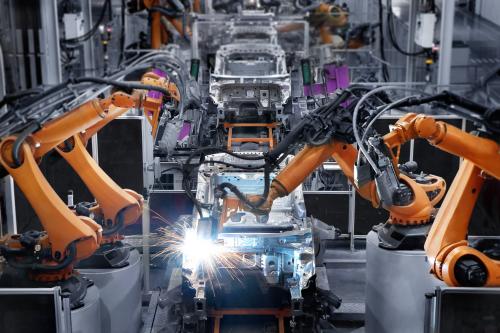Software is eating the world, goes the famous quip. So rapid are the developments, in fact, that while the “digitalization of everything” has become a hallmark of tech’s promise of individual and business empowerment, so has it begun to prompt anxiety, including among workers who worry about their future in a world of brilliant machines.
Which is why the Metro Program at Brookings has just released a new report on the labor-market effects of “digitalization”—the diffusion of digital technology into nearly every business, workplace, and pocket in the U.S.
Designed to help address the shortage of data on the topic, “Digitalization and the American workforce” builds on a detailed analysis of changes in the digital content of 545 occupations covering 90 percent of the U.S. workforce in all industries since 2001.
What have we found? Here are five quick takeaways:
1. The U.S. economy is digitalizing at hyper-speed
The first takeaway from the analysis is that between 2002 to 2016, the shares of U.S. jobs and employment that require substantial digital knowledge rose rapidly, whether because of changes in the digital content of existing occupations (the largest effect, by far) or thanks to shifts in the mix of occupations.

The changes have been striking. Since 2002, the share of all U.S. jobs that require extensive and mid-level digital skills has surged from 45 to 71 percent of the total. Since 2010, meanwhile, nearly 4 million of the nation’s 13 million new jobs created—30 percent of them—have required high-level digital skills.
2. Digitalization has been ubiquitous but its degree and pace varies widely among occupations and across industries
Looking broadly across the job rolls, digitalization scores rose in 517 of 545 analyzed occupations from 2002 to 2016. The average digitalization score across all occupations rose from 29 in 2002 to 46 in 2016, a 57 percent increase.
Overall, the most significant computerization occurred around the lower and middle tiers of the scale where the digital scores of many large and accessible occupations underwent radical increases as basic tech was introduced in low-tech industries.

3. Digitalization, which is a form of automation, is associated with increased pay and job resiliency but also “U-shaped” job creation patterns
Digitalization is a key pathway to increased earnings. All across the skills continuum, employees are rewarded for the depth and breadth of their digital skills through increased wages. Workers in occupations with medium or high digital skills in 2016 were paid significantly more than those in low-digital occupations.
Focusing on patterns of job creation, the digitalization of the U.S. economy appears to be contributing to the hollowing out and polarization of employment and wage distributions, noted by the MIT economist David Autor and colleagues. See the following depiction of job growth by occupational group (digital score):

4. The extent of digitalization also varies widely across places and is strongly associated with variations in regional economic performance
In geographical terms, digitalization is happening everywhere, but its progress varies widely across the map. (To view the digital status of your state or metro, check out these spreadsheets).
In almost all cases, metros saw their mean digitalization score increase by 12 to 18 points meaning that for the most part, digital laggards among metros were catching up to the digital leaders, allowing for metro digital scores to converge somewhat.

With that said, when mapped for their shares of employment in high-digital occupations, metros’ digital skills vary more widely and are diverging. In this regard, the digital rich are getting richer.
These trends underscore a key point about the influence of digitalization on regional prosperity: variations in the digital skills of the local workforce may be contributing to the polarization of cities’ economic fortunes.
5. Digitalization is changing the skills workers need to access economic opportunity while creating new race- and gender-based training challenges
Digitalization, as it proceeds, is changing the skills less-advantaged workers need to secure good jobs.
And here is another issue: the mean skills ratings of the jobs occupied by workers in major demographic groups vary in ways that almost certainly contribute to those groups’ uneven access to opportunity.
Women, with slightly higher aggregate scores as a group than men, dominate employment in many of the largest medium-digital occupational groups, such as in health professions—but by contrast, remain significantly underrepresented in such highly digital positions as computer and mathematical occupations and engineering.
Equally sharp variation characterizes the employment profiles of the nation’s racial and ethnic groups.

While digitalization holds out significant opportunities for less-educated or historically marginalized workers or groups to move up the employment ladder, too few of them as yet appear to attaining that progress.








Commentary
Five takeaways on how technology has changed the American workforce
November 17, 2017